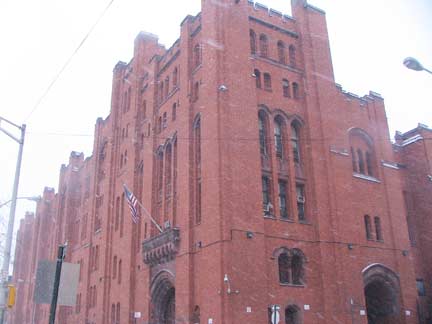Franklin Avenue Armory
1122 Franklin Avenue at 166th Street
Charles C. Haight
1908-1911
Addition: Benjamin W. Levitan
The Franklin Avenue Armory (originally called the Second Battery Armory and later the 105th Artillery Armory) was the first such facility erected in The Bronx. Modern armories had their origin in the United States during the second half of the nineteenth century when the social and economic disruptions of the second industrial revolution produced rapid changes. Factory workers often went on strike and rioted against low pay, oppressive working conditions and slum housing, while wealthy industrialists built mansions, cruised on yachts and threw elaborate balls and dinner parties. In response to the violent social unrest, armories were erected in city neighborhoods to be the last defense of civilization. They were stocked with arms and ammunition, manned by the local militia (later the National Guard) and designed as fortifications to weather any storming by rabble mobs. By the beginning of the twentieth century, such concerns greatly declined, but the basic fortification design of armories never changed. This is also true of the Franklin Avenue Armory.
This armory is built of dark red brick in the Gothic military style. The mortar between the bricks is tinted red to give the structure a more massive appearance. The brownstone trim blends in with the brick and mortar, while white limestone trim provides a welcome contrast. Three- to four story high slit-like openings pierce the massive walls. Three two-tiered windows are located above the entrance. These openings are outlined with Romanesque Revival arches. The roofline bears a notched parapet. The one-story addition along much of the Franklin Avenue frontage attempts to replicate the original features. The building houses a large drill shed with an administrative building to the side, all anchored by a corner tower.
Perhaps the most noted person to train in the Franklin Avenue Armory was William Francis Deegan, who rose to the rank of captain in the National Guard. An architectural engineer by profession, he was co-opted by the U.S. Army during World War I to design and build barracks for the troops in upstate New York, leaving with the rank of major. After the war, he took a leading role in organizing the American Legion, becoming its New York State Commander. In the 1920s, he served New York City as its official greeter and as its Tenement House Commissioner. In the early 1930s, he was elected president of the Bronx Chamber of Commerce. Today, the Major Deegan Expressway in The Bronx commemorates his service that had its beginnings in the Franklin Avenue Armory.
Lloyd Ultan
